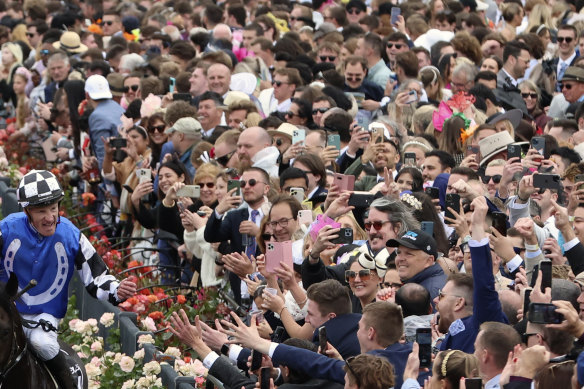Divisive Melbourne Cup makes strides in safety
The weather was uninviting, but nothing was going to stop the crowds from returning to the Melbourne Cup. After the COVID-19 pandemic called a halt to anyone turning up to watch in 2020, and only 10,000 vaccinated patrons were allowed trackside last year, a large crowd at Flemington on Tuesday was another welcome sign that life is returning to some normality in Melbourne.
That’s not to say the Cup was welcomed by everyone. A recent poll found more than 70 per cent believed the race was a “unique part of Australia’s national identity”, but 45 per cent said it promoted “unhealthy” gambling behaviour, and a third believed it normalised animal cruelty.
Crowds returned to the Melbourne Cup despite the weather.Credit:AP
For all the glitz and glamour of the day, it has been increasingly difficult to ignore the dark underbelly of horse racing. An ABC report in 2019 uncovered alleged acts of animal cruelty on a mass scale, along with allegations that hundreds of Australian racehorses were being sent to slaughterhouses. And the death of seven horses between 2013 and 2020 during the Melbourne Cup cast a pall over the event.
To its credit, the horse racing industry responded. In April last year, after a review by Racing Victoria, it implemented a raft of provisions, including mandatory CT scans for international and local runners, in an attempt to eliminate horses believed not healthy enough to race in the Cup – a gruelling event over 3200 metres. It has also restricted the use of the whip.
It had a major impact this year. The second favourite Loft was scratched last week after a vet inspection found the German import had injured a tendon. A mandatory CT scan also showed up a “grey area” in Caulfield Cup winner Durston’s left hind leg, which led to it being ruled out. This week, Point Nepean was scratched after returning elevated blood results, which suggested the horse was getting sick, while Lunar Flare was ruled out on Cup morning following a vet inspection.
Not everyone is happy. English trainer James Ferguson believes Racing Victoria’s stringent vetting requirements have “absolutely” put off internationals from targeting the Melbourne Cup, and long-time commentator Bryan Martin says the event is becoming a “laughing stock”. Considering the history of horse fatalities though, it would be hard to argue against the crackdown. While the enhanced safety measures cover all horses entered for the Melbourne Cup, the internationals are under much more scrutiny given the spate of deaths over the past decade have all been in imported horses.
Part of the thrill of the Cup is that it’s a global event, open to the best stayers in the world. But organisers should make no apology for making sure international horses are fit to run.
While there were no deaths, this year’s Melbourne Cup did not go without a hitch. Three horses – Camorra, Serpentine and Numerian – finished a long way back. Interpretation failed to finish. There were no reports of injuries to these or any other horse, but as they fell behind, there must have been many both inside and outside racing circles watching on tenterhooks.
In its 162-year history, the Melbourne Cup has never been cancelled, despite wars, depression and pandemics. But in recent years, its image has been tainted by controversy. If public support for the sport is to be maintained, the industry must stay vigilant to ensure that which horse crosses the finishing line first is not the only measure of success.
Michael Bachelard sends an exclusive newsletter to subscribers each week. Sign up to receive his Note from the Editor.
Most Viewed in Sport
Source: Read Full Article

